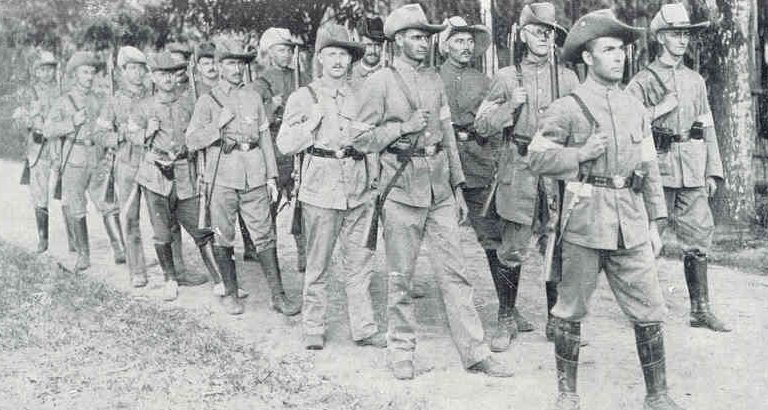Background to the
German Reservists on New Guinea
German men of military age living on the
islands of German New Guinea were called up as reservists upon the outbreak of
the First World War in 1914. Most, but not all, had undergone basic military
training back in Germany. Around fifty of these reservists on the Bismarck
Archipelago participated in the defence of Bita-Paka radio station against
the Australian invasion in September 1914.Uniforms of the Reservists on New
Guinea
Judging from period photographs the reservists had no regulation uniform but
all were common in that they wore some form of khaki uniform and most wore a slouch hat.
Some of the tunics were ill fitting, some had pockets some did not. To identify themselves they wore
green armbands on both arms. Green had been authorised as the official colony
colour for German New Guinea in 1912.
Period photographs show that the
reservists were armed with the G88 rifle and that their
equipment usually consisted of a single ammunition pouch (of a variety of types
including the 1889/95) on a leather belt with an other ranks naval
style belt buckle, as also worn by the New Guinea
Polizeitruppe.
| |
|
|
| |
The Illustrations Figure 1 is based on a
photograph of a German Reservist taken just prior to the Australian invasion of 1914. This
reservist is typical of their casual appearance in that he wears a loose fitting
khaki tunic without insignia or breast pockets. He wears a slouch hat hat pinned
up on the right hand side and green identification armbands on both arms. His
khaki trousers hang loose over his boots. The equipment worn consists of a
single
1909 ammunition pouch and a leather belt with the naval belt buckle.
Figure 2 is based on a
photograph of a German Reservist also taken just prior to the Australian invasion. This
reservist is also quite typical of their appearance. He has a slouch hat pinned
up on
the left side- the right side being the more common way to pin up the side of
the hat. He also wears a loose fitting khaki tunic without insignia. This time
the tunic has breast and hip pockets. The khaki trousers are worn tucked into
leather gaiters worn over leather boots. He carries one 1889/95 ammunition pouch
and a leather belt with the naval belt buckle.
Figure 3 is based on a
photograph of a German Reservist also taken just prior to the Australian invasion. This
reservist has a tropical helmet with a khaki cover. From it's shape it appears
to be the German 1891/96 model issued throughout the colonies. It may be
that this reservist is a Polizeitruppe NCO or junior colonial official. In
the same photograph upon which this illustration is based are several other
reservists. Most wear slouch hats but this man and one other wear tropical
helmets. The other helmet is lower and rounder in shape. This reservist also
wears a loose fitting khaki tunic without insignia. The khaki trousers are worn tucked into
puttees worn over short leather boots. He carries a German issue water
bottle. |
|
| |
|
|

German New Guinea Reservists
This photograph shows the reservists on a training exercise just after the
outbreak of war in 1914. Note the lack of standardisation with their
uniforms- some hats are lighter or darker than others, some with hatbands some without. Some of them have pockets on their tunics,
some do not. Some have their trousers worn loose while others wear
gaiters. This would imply that the uniforms did not come from a
central depot and may have been individually made or purchased from
various stocks.
Photo from the
Australian
War Memorial /
WikiMedia
Recommended External Links
The Battle of Bita-Paka
on FirstWorld War.com
The Battle of Bita-Paka on Wikipedia
The Australian Official History of the War in the Pacific at the Australian
War Memorial Website
|